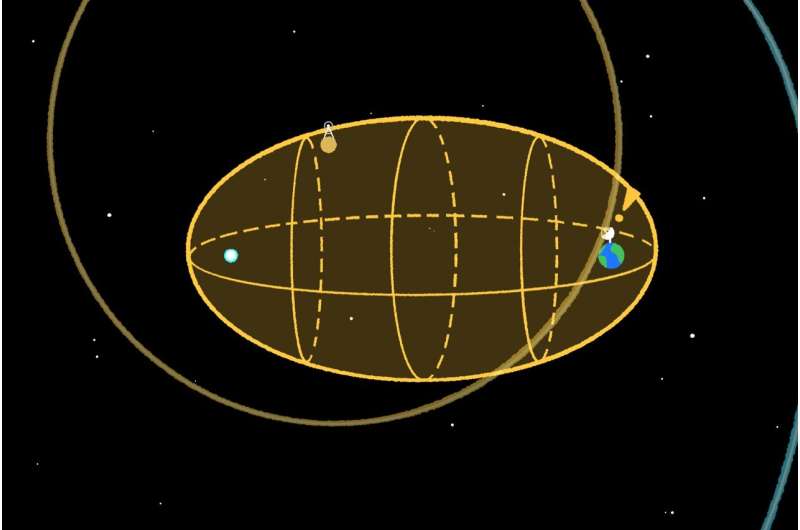
SETI ellipsoid. Credit: Zayna Sheikh
A team of researchers from the SETI Institute, Berkeley SETI Research Center and the University of Washington reported an exciting development for the field of astrophysics and the search for extraterrestrial intelligence (SETI), using observations from the Transiting Exoplanet Survey Satellite (TESS) mission to monitor the SETI Ellipsoid, a method for identifying potential signals from advanced civilizations in the cosmos.
The SETI Ellipsoid is a strategic approach for selecting potential technosignature candidates based on the hypothesis that extraterrestrial civilizations, upon observing significant galactic events such as supernova 1987A, might use these occurrences as a focal point to emit synchronized signals to announce their presence.
In this work, researchers show that the SETI Ellipsoid method can leverage continuous, wide-field sky surveys, significantly enhancing our ability to detect these potential signals. By compensating for the uncertainties in the estimated time-of-arrival of such signals using observations that span up to a year, the team implements the SETI Ellipsoid strategy in an innovative way using state-of-the-arc technology.
“New surveys of the sky provide groundbreaking opportunities to search for technosignatures coordinated with supernovae.” said co-author Bárbara Cabrales.
“The typical timing uncertainties involved are a couple of months, so we want to cover our bases by finding targets that are well-documented over the course of about a year. In addition to that, it’s important to have as many observations as possible for each target of interest so that we can determine what looks like normal behavior and what might look like a potential technosignature.”
In examining data from the TESS continuous viewing zone, covering 5% of all TESS data from the first three years of its mission, researchers utilized the advanced 3D location data from Gaia Early Data Release 3. This analysis identified 32 prime targets within the SETI Ellipsoid in the southern TESS continuous viewing zone, all with uncertainties refined to better than 0.5 light-years.
While the initial examination of TESS light curves during the Ellipsoid crossing event revealed no anomalies, the groundwork laid by this initiative paves the way for expanding the search to other surveys, a broader array of targets, and exploring diverse potential signal types.
Applying the SETI Ellipsoid technique to scrutinize large archival databases signifies a monumental step forward in the search for technosignatures. Utilizing Gaia’s highly precise distance estimates, the study demonstrates the feasibility of cross-matching these distances with other time-domain surveys like TESS to enhance monitoring and anomaly detection capabilities in SETI research.
The SETI Ellipsoid method, combined with Gaia’s distance measurements, offers a robust and adaptable framework for future SETI searches. Researchers can retrospectively apply it to sift through archival data for potential signals, proactively select targets, and schedule future monitoring campaigns.
“As Dr. Jill Tarter often points out, SETI searches are like looking for a needle in a 9-D haystack,” said co-author Dr. Sofia Sheikh. “Any technique that can help us prioritize where to look, such as the SETI Ellipsoid, could potentially give us a shortcut to the most promising parts of the haystack. This work is the first step in searching those newly-highlighted parts of parameter space, and is an exciting precedent for upcoming large survey projects like LSST.”
The research is published in The Astronomical Journal.